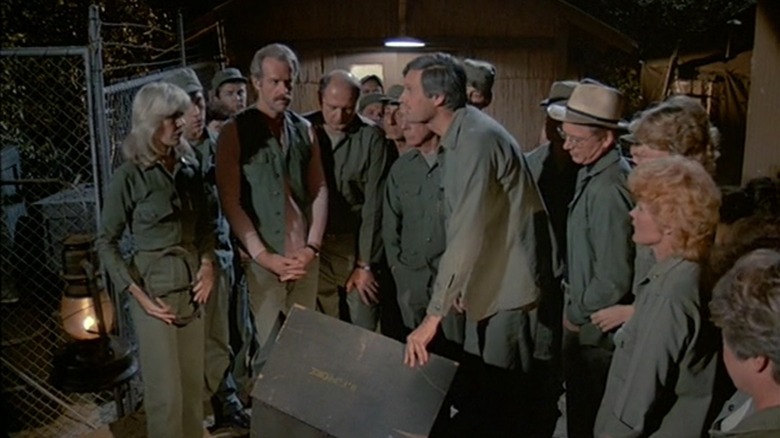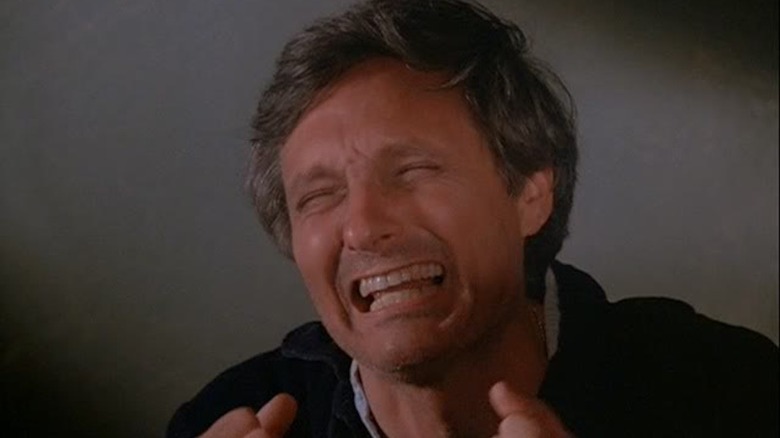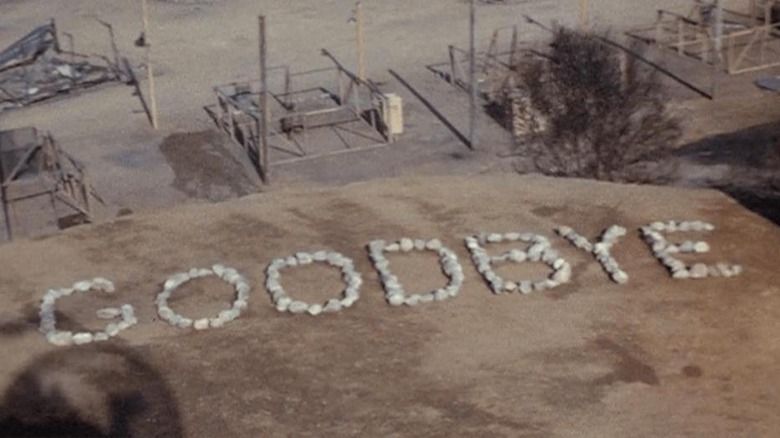The M*A*S*H Finale's Set Was Reduced To Ash In The Middle Of Filming
In terms of actors, the sole link between Robert Altman's "M*A*S*H" and the long-running CBS sitcom is Gary Burghoff, who played the nerdy, childlike company clerk Eugene "Radar" O'Reilly. But while the series gradually became a less ribald and more humanistic take on characters, it retained some of the film's anarchic spirit by shooting on its still-standing locations at the Fox Ranch in Malibu Creek State Park. The TV crew made some minor alterations to the tents, but for the most part the show's exteriors were identical to the film's. All told, this was a minor flourish that was lost on most viewers, but for fans of Altman's movie, it was a nice gesture that linked the series to its considerably rowdier (and undeniably problematic) predecessor.
Using the 4077th's Malibu exteriors created a bit of a spatial disconnect when the series was assigned Stage 9 at 20th Century Fox Studios. This was the smallest soundstage on the lot, and it didn't match up to the broader scale suggested by the exteriors. The operating tent's quarters were especially tight, and this artifice could clash when an episode cut back and forth between the soundstage and the ranch. This was initially a major source of irritation for co-creator/producer Gene Reynolds, but everyone eventually accepted the studio-bound limitations and, given the show's legendary 11-season run, managed quite nicely.
This isn't to say all was swell out west at the Fox Ranch. According to Ed Solomonson and Mark O'Neill's "TV's M*A*S*H: The Ultimate Guide Book," the compound had several drawbacks, one of which could've proved fatal for the cast and crew.
The downside to shooting (and living) in Malibu
One of the biggest issues with shooting at the Fox Ranch was its 20-mile distance from the studio. Shooting there came with the built-in cost of schlepping crew members, actors and equipment. But there was another, far more serious consideration: brush fires. In a 2000 interview with the Television Academy Foundation, Alan Alda recalled a particularly hairy close call. Per Alda:
"We had to be evacuated from [The Fox Ranch] once because of a fire that didn't, that time, hit the set. But we had to get out because they said, 'If you don't get out now, when it comes through, it's gonna come through at forty miles an hour.' And you can't get down the road that fast, you know, even in trucks because there's winding country roads."
"M*A*S*H" almost completed its 11-season run without incident, but in a stroke of remarkable bad luck, a fire swept through the ranch while they were shooting the two-hour finale and destroyed the 4077th's encampment. It was a potentially devastating blow, but the producers rolled with the punches and wrote the fire into the show.
The writers made a miraculously quick recovery
Though the show successfully adapted to this unexpected act of god, they still needed to rebuild the old 4077th sets, which figure prominently into the bulk of "Goodbye, Farewell and Amen." It was a daunting prospect. According to Alda, "[A]ll these buildings, you know all those metal buildings, all that was left was little puddles of aluminum on the ground. It was just amazing."
Amazingly, the writers only needed six days to work the fire into the script. The crew returned to the Fox Ranch to shoot the new scenes, and did a sensational job because, having rewatched the finale recently, nothing feels forced.
"Goodbye, Farewell and Amen" aired on February 28, 1983, and was the most watched broadcast in American history until Super Bowl XLIV in 2010. When it comes to series finales, it is the epitome of sticking the landing. And the whole thing almost went up in flames.


